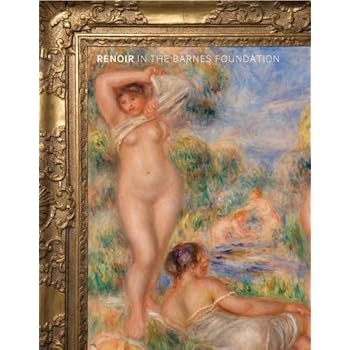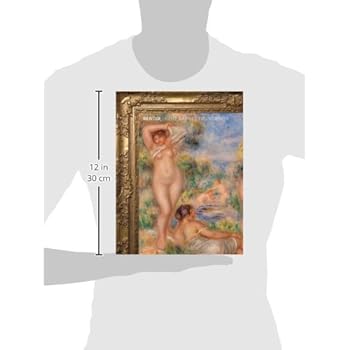Renoir in the Barnes Foundation
Category: Books,Arts & Photography,Individual Artists
Renoir in the Barnes Foundation Details
Book Description This lavish and richly researched catalogue investigates Renoir's role in the development of modern art and the Barnes Foundation's importance in establishing his reputation as one of the most significant painters of the 20th century. Read more About the Author John House was emeritus professor at the Courtauld Institute of Art in London. Martha Lucy is associate curator at the Barnes Foundation in Philadelphia and Merion. Read more

Reviews
IN MEMORY OF JOHN HOUSE, AN OUTSTANDING SCHOLAR, TEACHER, AND MENTORAficionados of Renoir have been experiencing quite a bonanza lately. Only two years ago we had the publication in English of Anne Distel's huge, comprehensive and sumptuous monograph on the artist, and 2010 also saw two excellent exhibitions: the enormous "Renoir in the Twentieth Century" in Paris, Los Angeles, and Philadelphia with its massive catalogue, and the more focussed "The Genius of Renoir: Paintings from the Clark" at the Sterling and Francis Clark Art Institute in Williamstown, Mass. and the Prado in Madrid and its excellent catalogue, written by John House, the eminent Impressionism scholar from the Courtauld Institute in London. Already this year we have had the great "Renoir, Impressionism, and Full-Length Painting" at The Frick Collection in New York City and its wonderful catalogue, written by Colin F. Bailey (see my review on this website)--and two of that show's paintings from the Musee d'Orsay in Paris traveled subsequently to Boston's Museum of Fine Arts. And now we have finally the much anticipated reckoning of the Renoir collection of the Barnes Foundation, expertly written by Martha Lucy, Associate Curator at the Foundation and, once again, John House, whose unfortunate fate it was to suffer a sudden and untimely death just weeks before publication of the project on which he and Dr. Lucy had worked for so many years.This is one of the most important Renoir books ever published, because it is essentially a catalogue raisonné of the largest collection of Renoir paintings in the world. Over a period of thirty years, beginning in 1912, the wealthy physician and pharmaceuticals manufacturer Alfred C. Barnes amassed a collection of 181 works by the artist, encompassing all phases of his career, but with special emphasis on the late works--eighty-five percent of the canvases date from after 1900. Owing to Dr. Barnes's vision of his Foundation and the restrictive terms of his bequest, access to the collection has historically been very difficult (he personally denied even T. S. Eliot permission to see it). Visits by scholars were not welcome, and as a result only a few of the pictures had received critical attention since the publication of Barnes's own Renoir book in 1935. More importantly, the works had never even been catalogued, and their histories--provenance, prior exhibition lists, previous titles, etc.--were for the most part entirely undocumented. This was the huge task that Drs. House and Lucy undertook, and the result is this magnificent volume.There are three introductory essays, the first of which is John House's succinct overview of Renoir's artistic career. Then come two essays by Martha Lucy, one grappling in a very informative way with the issue of Renoir's "modernity" and Barnes's particular quest for it in art, and the other discussing what happened to the 720 works left in the painter's studio after his death. The main body of the book is the catalogue of all 181 works in the collection, divided into a selective catalogue and a thematic catalogue. The selective section presents sixty-four large, major or particularly representative paintings in full-page reproductions. Each is accompanied by a signed annotated discussion of at least one page by one of the authors and, usually, a number of comparison illustrations (the jacket text informs us that there are a total of 555 color illustrations, and there are numerous black-and-white photographs interspersed). The thematic section reproduces the remainder of the collection in smaller format (one, two, or three to a page), gathered into such categories as "Nudes," "Figures in Landscape," "Children," etc., each category prefaced by a brief essay. There follow sixty-five pages of documentary apparatus providing for each painting, wherever appropriate, the original title, provenance, prior exhibitions, references, marks and inscriptions, and technical notes. There is a twenty-six page chronology of exhibitions from 1886 to 1942, with special emphasis on Barnes's acquisitions, an extensive selected bibliography, and a detailed index of works, names, places, etc. Obviously, its almost four hundred pages make it a very major contribution to the literature on Renoir, and the dedicated work and outstanding scholarship of its authors assure us of its authoritative stature. It should appeal to those wishing to see glorious reproductions of some of his most famous works, many of them for the first time, and with its meticulous scholarly apparatus it will be invaluable to art historians as well. It is also a superbly designed and printed volume, displaying the high standards of art book production that we have come to expect from Yale University Press-- a necessary acquisition for all art libraries and all devotees of Renoir's art.



